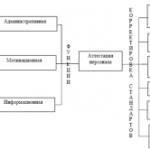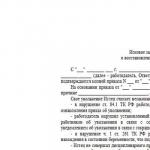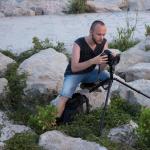Large snail - description, habitat, interesting facts. Snail bird, description of appearance, habitat, habits Where does the big snail live
Kulik-selyanets (earlier - Ulіt vyalіki)
Brest region - single registrations in the east
Vitebsk region - nesting
Gomel region - single registrations in the west
Minsk region - extreme north and extreme northeast
Mogilev region - west and center
Snipe family - Scolopacidae.
Monotypic species, does not form subspecies.
Rare breeding migratory species. Nesting has been proven by only a few finds in the Vitebsk region: 06/21/1975 a downy chick was caught in the Berezinsky Reserve; 05/06/1987 a nest with a clutch of 4 fresh eggs was found in the Liozno region; On May 21, 1995, a nest with 4 fresh eggs was found in the Shumilinsky district; On May 18, 2002, another nest with 3 fresh eggs was found there. One of the latest findings of 4 pairs + chick occurred on May 26, 2013 in the Krasny Bor reserve, Rossony district. Also separate pairs of large snails with clear signs nesting behavior was recorded in spring and summer on raised bogs in other areas of the Vitebsk region. (Miory, Sharkovshchinsky, Vitebsk).
In addition, large snails with signs of nesting behavior were recorded in some swamps of the Mogilev, Gomel and Brest regions, but nesting here requires confirmation by findings of nests or non-flying chicks. In the southern part of the republic summer period registered in the Olman swamps, where there is probably an isolated settlement, since the nesting of the species has been proven in the border regions of Ukraine.

Relatively large chick. The coloration of the plumage is very similar to the marshmallow, the main differences are noticeably larger sizes and a slightly upturned beak. The upper body is light brown in color with white streaks, especially on the front of the back. Its back and loins are white. The underside of the body is also white, but there are black-brown longitudinal streaks on the goiter and chest. The outer tail feathers are white, the middle pair is smoky gray with dark transverse stripes. The beak is of medium length, laterally compressed and noticeably bent upwards. Its coloration is dark brown. Legs brownish green. The rainbow is brown. Male weight 155-180 g, female 148-195 g. Body length (both sexes) 33-37 cm, wingspan 62-70 cm. Male wing length 18-19 cm, tail 7.5-8.5 cm, tarsus 6.5-7 cm, beak 5-6 cm. Wing length of females 18-19.5 cm, beak 4.5-6 cm, tarsus 6-6.5 cm.

Like other snails, they willingly sit on trees, especially on dry tops and branches. Large flocks do not form. Even during flights they are kept in small groups. Very careful birds.
The large snail lives mainly in forest swamps or swampy river floodplains adjacent to the forest, along the shores of forest lakes, among vast raised and transitional swamps, sparsely overgrown with marsh pine and shrubs. Sometimes it settles in open areas of floodplain meadows overgrown with tall grass, shrubs with solitary trees.
A characteristic nesting bird of raised bogs of the Belarusian Poozerie. It is most numerous in the ridge-lake complex of vegetation and near large marsh lakes with rafted shores. It also occurs in the ridge-hollow complex with pine, giving preference to rafted areas.

Breeds in separate pairs, choosing the most deaf uninhabited areas. When nesting, the most secretive of the shorebirds, in Poozerye, as a rule, nests in marsh pine forests, even in very close wild rosemary on low manes and along the edges of islands, in groves along the banks of marsh lakes.
Most often, the snail was noted in flooded open areas. However, the first nest of a large snail, discovered on 05/06/1987, was located in a sphagnum pine forest along the edge of a small raised bog in the Liozno district of the Vitebsk region. The nest was on a tussock, open, near several pines: one dry (3 m high) and two green (1.7 and 2.0 m high).
The nest is made on the ground, usually in a dry place, under the cover of a bush or near the trunk of a fallen tree.

The nest is a hole trampled in a moss tussock, hidden among sedge, heather or wild rosemary, lined with dry blades of grass, pine needles, moss.
The tray of the first found nest was abundantly lined with dry pine needles with a small admixture of small heather twigs.
When examining one incomplete clutch of three eggs on 18.05.2002, there was no lining in the tray; in other nests with full clutches, the trays were lined with dry leaves of blueberry, marsh myrtle, and thin flakes of pine bark. Also, pine needles were always present in the tray, since the nests were often located under the cover of swamp pines, often on near-trunk moss tussocks. One more interesting feature large snails is that they almost always nest near the dry trunks of fallen marsh pines.
Nest sizes: tray diameter 9.3–14.0 cm, average 11.9±0.6 cm; tray depth 3.5–7.5 cm, on average 5.3±0.5 cm.
 Vladimir Bondar. Zatoka "Technopribor", ok. Mogilev
Vladimir Bondar. Zatoka "Technopribor", ok. Mogilev
In a full clutch there are 4 eggs, in exceptional cases 5. On the territory of Europe, single finds of clutches are known, consisting of 7 or 8 eggs (they belong to more than one female). In the surveyed full clutches in Poozerye there were 3–4 eggs, on average 3.9 ± 0.1 eggs per clutch. The shape of the eggs is pear-shaped. The shell is slightly shiny, sometimes matte. The color of its main background varies from light yellowish brown or dark creamy to yellowish gray. Large and small surface spots, sometimes larger strokes or relatively small streaks and specks of dark or black brown or light reddish brown. They are evenly distributed or concentrated mainly at the obtuse pole. Deeper spots are light gray, purple gray and brownish gray. Egg sizes: 32.7–42.4x46.7–55.0 mm, on average 34.7±0.3x49.9±0.3 mm. The weight of the eggs is 25.70–32.56 g, on average 28.96±0.37 g.

The bird starts nesting in the first days of May, but fresh clutches can be found in the first decade of this month. In friendly warm springs, fresh clutches were found in Poozerye from May 6 to 8, and in cold, prolonged springs, an incomplete clutch of three eggs was examined on May 18 and a complete fresh clutch in another nest on May 21. The clutches of varying degrees of incubation were examined from 9 to 23 May. A freshly dried chick was found on April 25, 2008, 23 m from the nest (a dead downy chick and egg shells were in the nest itself). Nestlings in downy plumage, but of different sizes were observed from 15 to 21 June; chick that began to fledge was observed on 10.06.2000.
One brood per year. The male and female incubate the clutch for 24-25 days; later, both birds lead the chicks and protect the brood when threatened. Large snails incubate the clutch very tightly: flying up to 1.5–5 m from the researcher, sometimes they move away, imitating a wounded bird.
Immediately after hatching, the large snail transfers the chicks to watered open areas, where adult birds become very noticeable by the cries of alarm heard from afar.

Autumn departure begins in mid-August and continues throughout September.
The food of a large snail is various invertebrates, primarily insects and their larvae (including aquatic ones), arachnids, and small mollusks.
Adult large snails are found in the prey of the golden eagle, and chicks in the merlin.
The number of large snails in those raised bogs of the Belarusian Poozerie, where it nests, ranges from 1 pair per 10 km² (in swamps with an area of at least 1000 ha) to 6 pairs per 10 km² (in smaller swamps). Drainage reclamation of raised bogs has a significant impact on the number of large snails in the Belarusian Poozerye and, to a lesser extent, a disturbance factor.
Included in the "Red Book of the Republic of Belarus".
The maximum registered age in Europe is 24 years 5 months.
 Vladimir Bondar. Zatoka "Technopribor", ok. Mogilev
Vladimir Bondar. Zatoka "Technopribor", ok. Mogilev

Literature
1. Grichik V.V., Burko L.D. "Animal world of Belarus. Vertebrates: textbook" Minsk, 2013. -399p.
2. Nikiforov M. E., Yaminsky B. V., Shklyarov L. P. "Birds of Belarus: A guide to identification of nests and eggs" Minsk, 1989. -479 p.
3. Fedyushin A. V., Dolbik M. S. "Birds of Belarus". Minsk, 1967. -521s.
4. Ivanovsky V. V., Vorobyov V. N., Mindlin G. A. "Materials for the ecology of shorebirds of the Belarusian Lakeland" / Bulletin of the Vitsebsk State University. 2015. No. 1. P.38-43
5. Minutes of the meeting of the Belarusian Ornithological and Faunal Commission (BOFC) dated February 17, 2015
6. Mongin E. A. "Big Snail" / Red Data Book of the Republic of Belarus. Animals. Rare and endangered species of wild animals. Ed. 2nd. Minsk, 2006. P.126-127
7. Kozlov V.P., Lychkovsky B.D. "On the nesting of a large snail in the Belarusian Lakeland" / Abstracts of the 12th Baltic Ornithological Conference. Vilnius, 1988. S.94-95.
8. Fransson, T., Jansson, L., Kolehmainen, T., Kroon, C. & Wenninger, T. (2017) EURING list of longevity records for European birds.
Eurasia from Scandinavia east to Anadyr and Kamchatka, south on the Russian Plain to about the 54th parallel (1). The southern border of the range passes through the Ryazan region. In the 90s. 19th century was a common but sporadically nesting species of the Oka valley and a number of lakes in the Meshcherskaya lowland (2). In the 1990s a large snail was found nesting in the Pra valley in the north of the Ryazan region (3) and on the left bank of the Oka near the border of the Spassky and Shklovsky regions (4). In the same years, it was recorded in some tracts on the territory of the Kasimovsky district, where it probably nested (5, 6). Probably nested in the vicinity of the village of Barsky, Ryazan region (2004) and in 2007, 2008. in the north of the Spassky district, where it was found during the breeding season (7-9). During spring and autumn migration the view is quite common. There is little specific data on nesting. Over the past century, the number of nesting birds, apparently, has declined significantly. In the last decade no nests have been found. According to a rough estimate, no more than 10-20 pairs nest on the territory of the region.
Habitats and biology
The large snail nests in grassy swampy glades of pine and birch forests, in raised bogs, overgrown shores of lakes with individual trees. The nest, which birds can use for several seasons, is located near or between stones, hummocks, or on top of a hummock. As a rule, the nest is located near objects protruding high above the ground. Monogamous. During the season, one clutch, in a full clutch of 4 eggs. The duration of incubation of masonry is 23-26 days. Soon after hatching, the parents take the chicks away from the nest for a distance of up to 1.5 km. The chicks fledge at the age of 25-31 days (10).
Limiting factors and threats
The draining of swamps, as a result of which habitats are degrading, has a negative impact on the state of the species in the region.
Protective measures taken and necessary
The species is included in Appendix III of the Berne Convention. In the Ryazan region, the large snail has been under protection since 2001 (11). Potential Locations nesting sites are protected in the Oksky Reserve, in the state nature reserves of regional significance Boloto Koshelnitsa, Krasnoye Bolot, Boriskovsky, Boloto Progon (Ryazan district), Giblitsky, Shcherbatovsky, natural monuments of regional importance White Forest", "Grain" ( Kasimovsky district) and NP "Meshchersky". It is necessary to organize special studies to study the current distribution and abundance of the species in the region and give the found nesting sites the status of specially protected natural areas.
Vida
Appearance and behavior. The largest of the snails, almost the size of a dove, with a relatively long beak and long legs. The general color tone, except for the white belly, is light gray. The wings are long, sharp and narrow. Body length 30–35 cm, wingspan 53–60 cm, weight 135–270 g. Males and females are colored the same.
Description. Adult birds in breeding plumage are white below, with brownish-black longitudinal stripes on the throat, neck, chest and sides. The head and neck are also streaked with black longitudinal stripes. The interscapular and humeral regions, as well as the wings are gray with black on top, with white spots and black transverse stripes. The middle of the back and rump are white. In a flying bird, the white coloration of these parts of the body is clearly visible in the form of a wedge, extending far into the back. The underside of the wing is light. The tail feathers are white with a brown transverse pattern. The tail is straight cut, only the central pair of tail feathers is slightly longer than the others and has grayish tops. In a flying bird, only the fingers protrude beyond the edge of the tail. Legs olive-greenish or greenish-gray. Between the bases of the middle and outer fingers there is a very small membrane, between the middle and inner fingers it is practically not expressed. The beak is gray-slate, powerful, with a characteristic slight upward bend in the anterior third. The rainbow is brown.
Adult birds in winter plumage are white below with brown spots on the neck in front and on the sides. The pattern of the upper side of the body is like that of birds in summer, but the dark areas of the plumage are generally gray. The middle of the forehead and sides of the head are white. Juvenile bird in juvenile plumage is brownish-brown above with pale buffy edges of feathers. The underside of the body is white, on the sides of the neck and chest there are brown longitudinal stripes and a slightly noticeable brown transverse wavy pattern. The middle pair of tail feathers is the same color as the adjacent ones.
Young birds in the first winter plumage are similar to adults in winter, but the middle pair of tail feathers are without gray tips. The downy chick is light brownish above with blackish, irregularly shaped spots, pure white below. A black wide stripe runs along the middle of the back, along its sides - along a pale buffy stripe. The forehead is white, from the base of the beak through the middle of the forehead to the crown of the head there is a black stripe, another black stripe stretches from the beak to the eye through the bridle. The middle of the crown is black with pale buffy spots and stripes. A white stripe goes over the eye to the back of the head. It differs from other snails in its large size and rather powerful long beak with a characteristic slight upward kink in the apical third. The white color from the loin and rump comes in an angle far to the back.
In a flying bird, only the ends of the fingers protrude beyond the edge of the tail, which, together with large sizes and a powerful beak well distinguishes a large snail from.
Voice. Call in flight - loud two-syllable " tyuyu-luyuv"or trisyllabic" tuyuv-lyuyu-voluyuv". When taking off from the ground, they emit a sonorous powerful " tuy" or " bye-bye". Current song - loud unhurried " tu-ve, tu-ve, tu-ve..." or " aphids, aphids...". The cry of concern near the brood is a sharp loud " tu-tu-tu-tu...».
Distribution, status. The forest zone of Eurasia from Scotland and the Scandinavian Peninsula to Kamchatka and the lower reaches of the Amur. In the north it reaches the forest-tundra, in the south up to the subzone of mixed forests, in Western Siberia in some places it goes into the forest-steppe. In the European part of Russia, it breeds from forest-tundra to mixed forests, most common in the middle and northern taiga. It winters in Africa, the Middle East, the south of the Caspian Sea, Pakistan, India, Indochina, east China, Indonesia and Australia.
Lifestyle. Arrives at breeding sites early, by the beginning of the growing season of near-water vegetation - from mid-April in the south of the nesting range and until mid-May in the north, in the forest-tundra. Flies singly or in flocks. For feeding and rest, it stops along the banks of rivers on floodplain floods and near lakes with grassy shores, on sedge and cottonseed watershed bogs. After distribution over territories, males start displaying. During the current flight, which is an alternation of ascents and descents, the male flies over his area with a song. After the formation of a pair, the current intensity decreases. A couple from a couple settles at a considerable distance. Nesting habitats - grass and sedge-moss bogs, damp meadows, overgrown peat quarries, grassy shores of forest lakes, extensive clearings among pine forests, raised bogs, moorlands, forest-tundra shrub woodlands with swamps.
The nest is located on the ground among dense low-growing shrubs, often near a small tree or stump, on moss tussocks, between fallen trees in clearings, between stones on mountain bushy slopes, in any case - near a large noticeable object. The clutch consists of 4 pear-shaped eggs, in which blackish or reddish-brown large and small spots are scattered over a pale-brown, pale-olive or cream background. The nest is lined with thick moss, lichen, twig fragments, pieces of pine bark, herbaceous plant stems, materials that can be found in the immediate vicinity of the nest. Both parents incubate the clutch for 24–25 days. In case of danger, they take off in advance or hide, leaving the nest only when a person approaches a close distance. If nests are destroyed, they may re-nest. When disturbed at the nest or near the chicks, they fly out to meet danger, fly around with frequent calls, sometimes imitate an attack, often sit on the tops of trees.
After the chicks hatch, the families move to the shore of a reservoir, to a swamp or to a damp place in a forest or meadow. Chicks swim well, willingly go into the water and swim across small reservoirs. Both parents lead the chicks, in some cases the female leaves the brood before the young birds rise to the wing. Chicks become flying at the age of about a month. It feeds mainly on aquatic insects - water striders and other water bugs, dipteran larvae, dragonflies, as well as fish fry. During wintering it eats small crabs, mollusks, polychaetes. It catches its prey in the water, and often goes deep into it, diving up to its belly, and also collects silt or wet sand from the surface. Regularly probes the silt. When catching fish, it runs in shallow water and makes deft sharp turns with its whole body from side to side, while plunging its beak and sometimes even its head into the water. The fish grabs the end of the beak across the body, then turns with sharp movements so that the head is directed to the pharynx, after which it swallows.
cheap(at cost of production) buy(order by mail cash on delivery, i.e. without prepayment) our copyright teaching materials on zoology (invertebrates and vertebrates):
10
computer (electronic) determinants, including: insect pests of Russian forests, freshwater and anadromous fish, amphibians (amphibians), reptiles (reptiles), birds, their nests, eggs and voices, and mammals (animals) and traces of their vital activity,
20
colored laminated key tables, including: aquatic invertebrates, diurnal butterflies, fish, amphibians and reptiles, wintering birds, migratory birds, mammals and their tracks,
4
pocket field determinant, including: inhabitants of water bodies, birds of the middle zone and animals and their traces, as well as
65
methodical benefits and 40
educational and methodological films on methodologies conducting research work in nature (in the field).
big snail, or river sandpiper, or light sandpiper (outdated) - Tringa nebularia

Appearance.
Almost the size of pigeon, dark beak slightly curved upwards. The coloration is brown-gray above, the undertail and rump are white, there are dark streaks on the crop, sides, throat, back and shoulders. The legs are long, dark green, the wing is striped below.
Loud melodic two-syllable whistle “aphid-tuii”.
Habitat.
Lives in forest swamps.
Nesting places.
Typical nesting sites for the great snail are areas of coastal meadows overgrown with grass and low shrubs, moss swamps with small lakes and sparse pine forests, as well as extensive marshy clearings with isolated trees.
Nest location.
Nests on the ground. The nest is usually located in a dry area near a bush, between rocks, or near a fallen tree trunk.
Nest building material.
For lining the tray uses grass leaves, pine needles.
The shape and size of the nest.
It is a shallow hole in the moss or in the soil, sparsely lined with leaves of grass, pine needles.
Masonry features.
The clutch contains 4 cone-shaped eggs. Their color is yellowish-brown, cream or yellowish-white. Toward the blunt end of the egg, there are sharply defined large red-brown spots, as well as smaller marks and a small number of deeper greyish-blue spots. Egg size: (45-54) x (31-36) mm.
Nesting times.
Arrives at nesting sites on different dates of April. Nests with eggs are found in May, downy chicks - at the end of May June. Departure takes place in the second half of August - September.
Spreading.
Distributed throughout almost the entire taiga zone, in places in the forest-tundra and forest-steppe from Britain to Kamchatka. To the south, it is distributed in the northwestern lake region, along the valleys of the Oka and Kama rivers, and in negligible numbers further south; in addition, it is found in the mountains of Central Asia.
Wintering. Winters partly in Britain, Transcaucasia, but mainly in Africa, South Asia, Australia and New Zealand.
Economic value.
The meat of a large snail is excellent in comparison with many other waders, yielding little to the meat of a snipe. In view of his extreme caution, the snails shoot mainly at the places of evening feeding, lying in wait from an ambush.
Description of Buturlin.
Big snail - really the most big from snails. It is almost the size of a lapwing, although at first glance it seems smaller than the latter due to shorter and much narrower wings.
In the distance, a large snail seems light, in autumn almost whitish or ashy, and in the summer the bright white coloration is sharply distinguished not only on the uppertail and loin, but on the entire rear part of the back. According to these features, one of the waders of the southern half of our country, the handguard, is very similar to a large snail, but this latter is one and a half times smaller. Julit is easy to recognize by his sonorous cry“kyu-ku-ku...” or “fuu-fuu...”.
Plumage the upper side is brown, with blackish centers of feathers and smoky-brown wide edges, and on the head with white edges. The throat, goiter, chest and sides are white, with brown marks; the abdomen is white. Underwing coverts and axillary feathers; with smoky transverse spots or stripes. Tail feathers, except for one or two side pairs, with brown transverse stripes. In the autumn attire, the mantle is grayer and lighter, the black color is reduced to core stripes; the bottom is almost all white, only on the sides of the goiter and chest are dark dashes. In young, the mantle is brown, with buffy and whitish marginal spots; goiter feathers with narrow, even dark edges.
The eye is brown; the beak is brown, slightly curved upwards, but not arched, but at a very obtuse angle; legs olive or yellowish green. Wing length 15.5-20 cm. The plumage of the bridle does not reach the posterior edge of the nostril by 1.5-2.5 mm.
In spring, the first large snails are shown in the southern parts of our country about the middle of April, singly, in pairs and in small flocks; at the beginning of May, they appear already in the Leningrad region, and at the end of the middle ten days of May - even on the lower Pechora, beyond 65 ° north latitude.
Having broken into pairs, the sandpipers arrange their nests mostly in forest swamps, each pair at some distance from the other. The nest is most often placed near any tussock, stone or fallen tree. nests and eggs ordinary Easter cake type; eggs are 45.8 to 59.8 mm long and 32.4 to 37.7 mm wide.
Young in the northern region they fledge around 20 July. In the early days, they are very quiet, lurk tightly in the grass and reluctantly fly out from under their very feet. Parents and at this time protect them. It happened to observe that, noticing the approach of a person to such a brood of three hundred paces, the female, sitting on a dry top, warns the young with a frequent loud cry.
On our website you can read ornithology guide: bird anatomy and morphology , bird nutrition , bird breeding , bird migrations and bird diversity .
In the non-commercial online store of Ecological Center "Ecosystem" you can purchase the following methodical materials on ornithology:
computer(electronic) guide to birds of central Russia, containing descriptions and images of 212 bird species (bird drawings, silhouettes, nests, eggs and voices), as well as a computer program for identifying birds encountered in nature,
pocket guide-determinant "Birds of the middle band",
"Field guide to birds" with descriptions and images (drawings) of 307 species of birds in central Russia,
colored key tables"Migratory Birds" and "Wintering Birds" and also
MP3 disc"Voices of the birds of the middle zone of Russia" (songs, calls, calls, alarms of 343 most common species of the middle zone, 4 hours 22 minutes) and
MP3 disc"Voices of birds of Russia, part 1: European part, Ural, Siberia" (B.N. Veprintsev's music library) (singing or sounds during towing, calls, alarm signals and other sounds, the most important in the field identification of 450 species of Russian birds, duration sounding 7 hours 44 minutes)
A representative of the snipe family, a rare species that requires protection and protection. In this article, in a detailed format, we will talk about a big snail.
Description, appearance
The snail is not too large in size, the weight of adults ranges from 110 - 280 gr. The body shape is slightly elongated. Paws are dark green, rather long. The beak is upturned, the tip looks up. The wings, in comparison with the rest of the color, stand out. They are usually dark. From the head uniform and beautiful pattern small specks are distributed. The bottom of the body is white without any inclusions and peculiar patterns. Thanks to such an interesting color, a large snail cannot be confused with other birds. Young representatives are similar to adults, but there are some distinctive features. They have an off-white chest with dark markings, strokes and stripes.
Spreading
In Europe, he prefers to settle in the northern regions, in countries such as Russia and Scotland. Winters in the warmest places, for example, in Africa, Spain, Italy, where several dozen representatives were regularly seen. Individuals of this species are also found in the Caucasus, as in highlands as well as in swamps. Especially like to spend cold times in the south. For them there is the most favorable and suitable climate. And also there are all the possibilities for a peaceful existence, including the necessary food supplies.Very fond of various reservoirs, swampy areas. They migrate in small groups, about 10 birds.
Nesting and breeding
Their nest is a hole in the ground, usually enough small size. The female lays 4 eggs and incubates them for 24 days. They equip their nests near any source of water, it can be a river, a reservoir, a swamp. And also there must be a noticeable object nearby. They do this, guided by the instinct of self-preservation, which allows them to protect themselves from certain threats. Adult representatives are very caring, they accompany the chicks until they rise to the wing. The muscles of the kids are slowly getting stronger and getting stronger every day. But adult birds still show anxiety and anxiety.
Voice
Relatives

It is impossible not to talk about the so-called "relatives" of the big snail. This includes the Morodunka. It also has an upturned beak and an interesting coloration. But her paws are dark yellow. He also likes to winter in Africa, Western Europe. But in Italy it is rarely seen - it is rather an exception. Morodunka also spreads in Russia. As a comfortable place for their nests, they choose warm territories near rivers and various reservoirs. A very similar behavior pattern with large waders, they show concern for offspring.
population
A large snail is a worthy representative of its family. The bird has an unusual color, which allows you to immediately notice it. Unfortunately, a downward trend in this species has been observed. The issue became very acute, some measures were taken. After all, this greatly alarmed the experts. The ecology is deteriorating every year, many species of animals, birds and plants are disappearing. Therefore, we must try to preserve nature and what it has given. Measures are obligatory that help to improve the situation and create a certain balance and harmony that reigned until a person began to destroy everything that prevented him from achieving his selfish goals. Now actively began to implement measures to protect environment and it really helps.
So the number of large snails has increased over the past decade. The species has mastered new places, where it now equips its nests and raises offspring. For example, representatives of the family were seen in the Moscow region.
Measures taken to see improvements
It is worth noting the measures that helped to increase the numbers. Firstly, the species was listed in the Red Book. This allowed attention to such a problem as disappearance over a certain period of time. After all, every year the number became smaller. Protected nests have become an important role in the distribution of the large snail in the Moscow region. The day before, recommendations were put forward on the organization of places of protection for birds. They are under the protection of professionals, which will protect them. The snails found acceptable living conditions, a suitable climate. Now you can be sure that everything will be fine, and perhaps the species will "grow" and spread to other areas.
Video: big snail (Tringa nebularia)






